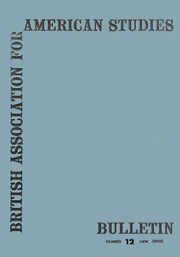No CrossRef data available.
Article contents
Across The Continent 1877–78
Published online by Cambridge University Press: 17 February 2011
Extract
In 1877 a thirty-one year old Wesleyan minister was returning, after twelve months at home in England, to the missionary work in China which he had begun in 1868. This time he decided to sail to New York, travel across the continent to San Francisco, and conclude his journey thence by sea. He was the Reverend Thomas Gunn Selby, son of a Nottingham lace manufacturer, and he recorded some of his impressions of the overland route in the journal entries reproduced below. Despite the inevitable brevity of some of his comments, the journal may be of interest to our readers for its first-hand and often graphic account of travel conditions, its reference to places familiar in another light to more recent visitors, the aspects of American religious activities on which it touches, and for many other details that emerge pleasantly ond spontaneously from his writing. This was Mark Twain's America, but not quite as Twain saw it. To Mr. Selby's account I have added only such notes as may clarify for the modem reader some ot his aliusions, but no attempt has been made to identify all the people he met.
- Type
- Research Article
- Information
- Copyright
- Copyright © British Association for American Studies 1964




